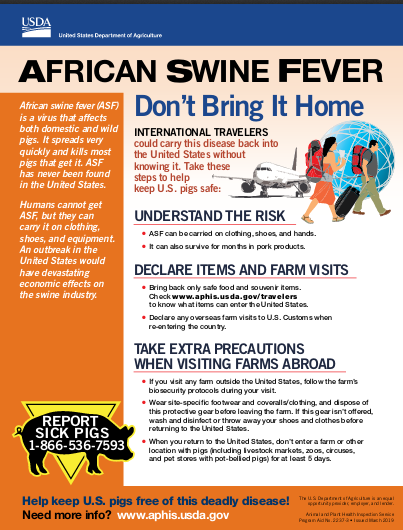 |
| Credit USDA |
#13,943
We've been following the devastating spread of African Swine Fever (ASF) in Eastern Europe, across much of China, and most recently in Vietnam for many months, and while this pig virus has never been detected in North America, the threat of seeing it arrive here someday is ever present.
Last Saturday, in Feds Seize 1 Million Pounds of Illegal Chinese Pork Products In New Jersey, we saw the the largest-ever seizure of agricultural products in U.S. history; roughly 1 million pounds of smuggled pork products from China.Contaminated food products - even those with cured or dried meat - can easily spread the virus to new regions, and may have contributed to the spread of ASF to - and across - China.
While American farmers may have dodged a bullet with the seizure of hundreds of tons of potentially contaminated pork products, the threat remains. And as more and more countries are affected, the avenues for ASF's import to North America only increase.
Today the USDA has released the following press release on the New Jersey interdiction, and of the combined efforts by many federal agencies, along with the private sector, to detect and intercept the virus before it can cause billions of dollars of damage to our agricultural economy.
Provides New Resources to Raise Awareness of the Deadly Disease
WASHINGTON, March 19, 2019 – Last week, USDA-trained detector dogs played a major role in the seizure of roughly 1 million pounds of pork smuggled from China where there is an outbreak of African swine fever (ASF). The highly contagious and deadly disease affects both domestic and feral (wild) pigs and there is no treatment or vaccine available for it.
Today, since prevention is our best protection against the disease, U.S. Secretary of Agriculture Sonny Perdue is sharing information about the importance of keeping ASF out of the United States. It is vital for everyone to know about ASF and how to prevent it, while keeping the U.S. pig population healthy.
To help people learn more about this disease, as well as the steps that can be taken to help protect U.S. pigs, the USDA’s Animal and Plant Health Inspection Service has updated its web content with additional information and links to partners’ resources. This information is available at www.aphis.usda.gov/animalhealth/swine/asf.
Additionally, USDA is releasing four infographics on the following topics:
- African Swine Fever Risk Pathways (PDF, 2.4 MB)
- Biosecurity (PDF, 312 KB)
- Signs and Symptoms of African Swine Fever (PDF, 209 KB)
- Traveler
- Tips (PDF, 389 KB)
USDA is monitoring the recent outbreaks of ASF is Asia and Europe, and has proactively taken steps to increase our safeguarding efforts to keep the disease out of the United States. These steps include:
USDA is committed to working with the swine industry, our producers, other government agencies and neighboring countries to prevent the spread of ASF. USDA tracks animal disease outbreaks around the world and remains on high alert to protect our farmers, our consumers and our natural resources from ASF or any foreign animal disease.
- Working with U.S. Customs and Border Protection at ports of entry, paying particular attention to cargo, passengers and products arriving from China and other ASF affected countries;
- Increasing detector dog teams with U.S. Customs and Border Protection to sniff out illegal products at key U.S. commercial sea and airports (last week four new beagles, Chipper, Marlee, Chaze and Cardie, completed training and were placed at Atlanta's Hartsfield-Jackson and Chicago's O'Hare airports);
- Collaborating with states, industry and producers to ensure everyone follows strict on-farm biosecurity protocols and best practices (including for garbage feeding in states where that is allowed);
- Restricting imports of pork and pork products from affected countries;
- Coordinating closely on response plans with the U.S. pork industry, producers and States to be ready should a detection ever occur in the United States; and
- Expanding the testing capabilities and testing capacity of the National Animal Health Laboratory Network.
 |
| Credit USDA |